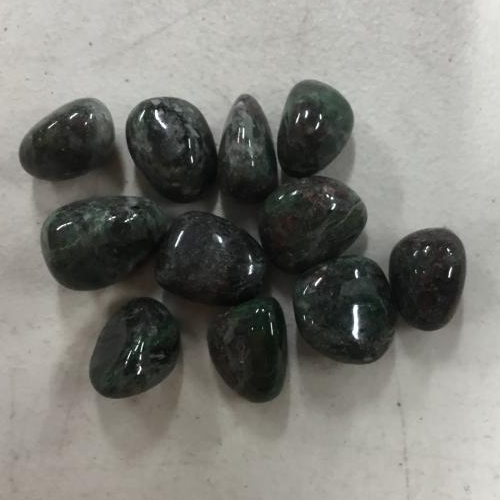Product Description
Eudialyte Tumbled Stone Top Grade 1"
Mineral Information:
Eudialyte is a complex and rare mineral that belongs to the silicate group. It is composed of a combination of elements including sodium, calcium, cerium, iron, manganese, zirconium, and aluminum. The chemical formula of eudialyte is typically represented as Na15Ca6(Fe,Mn)3Zr3Si(Si25O73)(O,OH,H2O)3(OH,Cl)2.
Eudialyte is known for its vibrant and varied colors, which can include shades of pink, red, brown, yellow, and green. It often exhibits a distinctive zoned or patchy appearance due to its complex composition and crystalline structure. The mineral typically forms in syenite or alkaline intrusive rocks and is commonly found in locations such as Greenland, Russia, Canada, and Norway.
In terms of physical properties, eudialyte has a hardness of 5 to 6 on the Mohs scale, making it relatively soft compared to other minerals. It has a vitreous to greasy luster and a translucent to opaque appearance. Eudialyte crystals are typically prismatic or tabular, and the mineral can also occur in massive or granular forms.
Eudialyte is valued as a gemstone and mineral specimen due to its unique and attractive colors. Its intricate patterns and color variations make it sought after by collectors and lapidary enthusiasts. It is often used in jewelry, carved into beads, or showcased as a decorative stone.
Metaphysical Properties:
Eudialyte is known to promote a heart-centered energy, and is associated with the heart chakra where in it is considered to assist with feelings of love, compassion, and emotional well-being. It is believed to open the heart chakra, allowing for open expression of love and nurturing energies. Eudialyte is said to enhance relationships, as well as creativity and inspiration. It also fosters spiritual growth and transformation.
Mineral Care:
Eudialyte is considered to have a moderate level of fragility. While it is not as delicate as some more brittle minerals, it is still relatively softer compared to many gemstones and minerals commonly used in jewelry.
Eudialyte has a hardness of 5 to 6 on the Mohs scale, which indicates that it can be susceptible to scratching and surface damage if not handled with care. This means that it is important to avoid rough contact with other harder materials that could potentially scratch or chip the surface of the stone.
In addition to its hardness, eudialyte can have a relatively brittle nature. This means that it may be more prone to breaking or fracturing under impact or excessive force. As with any gemstone or mineral, it is important to handle eudialyte gently and avoid dropping it or subjecting it to rough impacts that could lead to damage.
To protect and preserve the integrity of eudialyte, it is advisable to store it separately from other harder gemstones or minerals to prevent scratches. When wearing eudialyte jewelry, it is recommended to avoid activities that could potentially expose the stone to excessive force or impact, such as heavy physical activities or sports.
Proper care and cleaning of eudialyte can also help maintain its appearance and durability. It is best to clean eudialyte gently using mild soapy water and a soft cloth or brush. Avoid using harsh chemicals, ultrasonic cleaners, or steam cleaners, as they may damage the stone.
Disclaimer:
No information here is intended to diagnose, treat or cure ailments or afflictions of any kind. One should always consult a medical professional if a serious issue presents itself.







